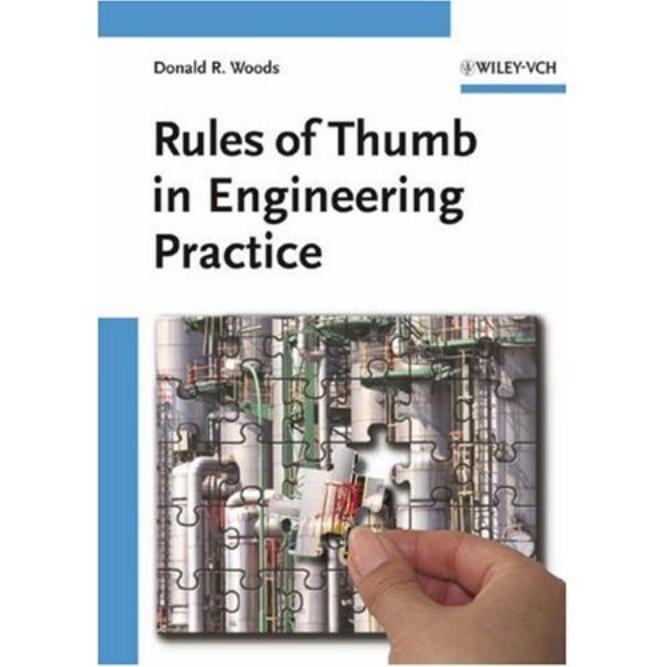
02 BOPs / Woods D.R 2008 rules-of-thumb-in-Engineering-practice (epdf.tips)
.pdf

Donald R. Woods
Rules of Thumb
in Engineering Practice

1807–2007 Knowledge for Generations
Each generation has its unique needs and aspirations. When Charles Wiley first opened his small printing shop in lower Manhattan in 1807, it was a generation of boundless potential searching for an identity. And we were there, helping to define a new American literary tradition. Over half a century later, in the midst of the Second Industrial Revolution, it was a generation focused on building the future. Once again, we were there, supplying the critical scientific, technical, and engineering knowledge that helped frame the world. Throughout the 20th Century, and into the new millennium, nations began to reach out beyond their own borders and a new international community was born. Wiley was there, expanding its operations around the world to enable a global exchange of ideas, opinions, and know-how.
For 200 years, Wiley has been an integral part of each generation s journey, enabling the flow of information and understanding necessary to meet their needs and fulfill their aspirations. Today, bold new technologies are changing the way we live and learn. Wiley will be there, providing you the must-have knowledge you need to imagine new worlds, new possibilities, and new opportunities.
Generations come and go, but you can always count on Wiley to provide you the knowledge you need, when and where you need it!
William J. Pesce |
Peter Booth Wiley |
President and Chief Executive Officer |
Chairman of the Board |

Donald R. Woods
Rules of Thumb
in Engineering Practice

The Author
Prof. Donald R. Woods
Chemical Engineering Department
McMaster University
Hamilton
Ontaria
Canada, L8S 4L7
All books published by Wiley-VCH are carefully produced. Nevertheless, authors, editors, and publisher do not warrant the information contained in these books, including this book, to be free of errors. Readers are advised to keep in mind that statements, data, illustrations, procedural details or other items may inadvertently be inaccurate.
Library of Congress Card No.: Applied for
British Library Cataloguing-in-Publication Data:
A catalogue record for this book is available from the British Library.
Bibliographic information published by the Deutsche Nationalbibliothek
Die Deutsche Nationalbibliothek lists this publication in the Deutsche Nationalbibliografie; detailed bibliographic data are available in the Internet at < http://dnb.d-nb.de >.
c 2007 WILEY-VCH Verlag GmbH & Co.
KGaA, Weinheim
All rights reserved (including those of translation into other languages). No part of this book may be reproduced in any form – by photoprinting, microfilm, or any other means
– nor transmitted or translated into a machine language without written permission from the publishers. Registered names, trademarks, etc. used in this book, even when not specifically marked as such, are not to be considered unprotected by law.
Printed in the Federal Republic of Germany. Printed on acid-free paper.
Composition Hagedorn Kommunikation,
Viernheim
Printing Betz Druck GmbH, Darmstadt
Bookbinding Litges & Dopf Buchbinderei
GmbH, Heppenheim
Cover Schulz Grafik-Design, Fußg nheim
Wiley Bicentennial Logo Richard J. Pacifico
ISBN: 978-3-527-31220-7

Contents
Preface XIV
1Rules of Thumb 1
1.1Rules of Thumb about Process Equipment 2
1.2Rules of Thumb about the Context for a Chemical Process: Physical and Thermal Properties 4
1.3Rules of Thumb about the Context for a Chemical Process: Corrosion 5
1.4Rules of Thumb about the Context for a Chemical Process: Process Control (based on communication from T.E. Marlin, McMaster University, 2001) 6
1.5Rules of Thumb about the Context for a Chemical Process: Batch versus Continuous 11
1.6Rules of Thumb about the Context for a Chemical Process:
Heterogenous Phase contacting 11
1.6.1GL Systems 11
1.6.2LL Systems 18
1.6.3GLS Systems 18
1.6.4Particulate Systems 20
1.7Rules of Thumb about the Context for a Chemical Process: Economics 21
1.8Rules of Thumb about the Thinking Process:
|
Problem Solving and Creativity 22 |
|
1.9 |
Rules of Thumb about the Thinking Process: Goal Setting 25 |
|
1.10 |
Rules of Thumb about the Thinking Process: Decision Making |
26 |
1.11 |
Rules of Thumb about the Thinking Process: Thermal Pinch |
26 |
1.12 |
Rules of Thumb about the Thinking Process: “Systems” Thinking 27 |
|
1.13Rules of Thumb about the Thinking Process: Design 30
1.14 |
Rules of Thumb about the Thinking Process: Process Improvement 31 |
1.15 |
Rules of Thumb about the Thinking Process: Trouble Shooting 31 |
1.16Rules of Thumb about the Thinking Process: Environment, Waste Minimization, Safety 32
Rules of Thumb in Engineering Practice. Donald R. Woods
Copyright c 2007 WILEY-VCH Verlag GmbH & Co. KGaA, Weinheim
ISBN: 978-3-527-31220-7

VI Contents
1.17Rules of Thumb about the People Part of Engineering: Communication 32
1.18 |
Rules of Thumb about the People Part of Engineering: Listening |
33 |
1.19 |
Rules of Thumb about the People Part of Engineering: People Skills |
34 |
1.20Rules of Thumb about the People Part of Engineering: Team and Group Skills 35
1.21Rules of Thumb about the Context in Which We Function: Performance Review 39
1.22Rules of Thumb about the Context in Which We Function: Leadership 40
1.23Rules of Thumb about the Context in Which We Function:
Intrepreneurship (based on Valikangas, 2003 and Cooper, 1987) 41
1.24Rules of Thumb about the Context in Which We Function: Entrepreneurship 41
1.25Rules of Thumb about the Context in Which We Function:
e-Business 42
1.26Rules of Thumb about Mentoring and Self-management 42
1.27Summary 43
2Transportation 45
2.1Gas Moving: Pressure Service 45
2.2Gas Moving: Vacuum Service 48
2.3Liquid 51
2.4Gas–Liquid (Two-phase Flow) 57
2.5Pumping Slurries: Liquid–Solid Systems 58
2.6Solids 59
2.7 Ducts and Pipes 63
3Energy Exchange 64
3.1Drives 64
3.2Thermal Energy: Furnaces 67
3.3 |
Thermal Energy: Fluid Heat Exchangers, Condensers and Boilers 68 |
3.4 |
Thermal Energy: Fluidized Bed (Coils in Bed) 79 |
3.5Thermal Energy: Static Mixers 79
3.6 |
Thermal Energy: Direct Contact L–L Immiscible Liquids 79 |
3.7Thermal Energy: Direct Contact G–L Cooling Towers 80
3.8Thermal Energy: Direct Contact G–L Quenchers 80
3.9Thermal Energy: Direct Contact G–L Condensers 81
3.10Thermal Energy: G–G Thermal Wheels and Pebble Regenerators and Regenerators 81
3.11Thermal Energy: Heat Loss to the Atmosphere 82
3.12Thermal Energy: Refrigeration 82
3.13Thermal Energy: Steam Generation and Distribution 83
3.14High Temperature Heat Transfer Fluids 84
3.15Tempered Heat Exchange Systems 85

Contents VII
4Homogeneous Separation 86
4.1Evaporation 87
4.2Distillation 90
4.3Freeze Concentration 101
4.4Melt Crystallization 101
4.5Zone Refining 102
4.6Solution Crystallization 102
4.7Precipitation 107
4.8Gas Absorption 107
4.9Gas Desorption/Stripping 113
4.10Solvent Extraction, SX 115
4.11Adsorption: Gas 118
4.12Adsorption: Liquid 119
4.13Ion Exchange 120
4.14Foam Fractionation 123
4.15Membranes and Membrane Configurations 123
4.15.1Membranes 124
4.15.2Membrane Operation and Configuration 125
4.16Membranes: Gas 128
4.17Membranes: Dialysis 129
4.18Membranes: Electrodialysis 129
4.19Membranes: Pervaporation 130
4.20Membranes: Reverse Osmosis, RO 131
4.21Membranes: Nanofiltration 132
4.22Membranes: Ultrafiltration, UF 132
4.23Membranes: Microfiltration 134
4.24Chromatography 135
5Heterogeneous Separations 137
5.1Gas–Liquid 137
5.2Gas–Solid 141
5.3Liquid–Liquid 144
5.3.1Decanter 146
5.3.2Hydrocyclone 148
5.3.3Sedimentation Centrifuge 148
5.4Gas–Liquid–Liquid Separators 149
5.5Liquid–Solid: General Selection 150
5.6Dryers 151
5.7Screens for “Dewatering” or Liquid–Solid Separation 159
5.8Settlers 160
5.9Hydrocyclones 161
5.10Thickener 162
5.11CCD: Counter Current Decantation 163
5.12Sedimentation Centrifuges 163
5.13Filtering Centrifuge 165

VIII Contents
5.14Filter 168
5.15Leacher 173
5.16Liquid–Solid: Dissolved Air Flotation, DAF 174
5.17Liquid–Solid: Expeller and Hydraulic Press 175
5.18Solid–Solid: General Selection 175
5.19Froth Flotation 176
5.20Electrostatic 177
5.21Magnetic 178
5.22Hydrocyclones 180
5.23Air Classifiers 180
5.24Rake Classifiers 181
5.25Spiral Classifiers 181
5.26Jig Concentrators 182
5.27Table Concentrators 182
5.28Sluice Concentrators 182
5.29Dense Media Concentrators, DMS 183
5.30Screens 183
6Reactors 185
6.1 |
Factors Affecting the Choice of Reactor |
185 |
|
6.2 |
General Guidelines 194 |
|
|
6.2.1 |
General Rules of Thumb for the Type of Reactor |
194 |
|
6.2.2 |
Specific Guidelines for Gas Phase, |
|
|
|
Liquid Phase and Gas–Liquid Reactions |
197 |
|
6.2.3 |
Specific Guidelines for Reactions using Catalysts |
199 |
|
6.2.4 |
Specific Guidelines for Gases Reacting with Solid |
207 |
|
6.2.5Bioreactors 207
6.2.6Reactors for Supercritical Conditions 209
6.2.7Reactors for Polymerization 209
6.2.8 |
Using the Phases to Guide in the Choice of Reactor Configuration 212 |
6.3 |
How the Type of Reaction Affects the Size of the Reactor 215 |
6.4Burner 224
6.5PFTR: Pipe/Tube, Empty Pipe for Fluid Systems 225
6.6PFTR: Static Mixer in Tube 227
6.7PFTR: Empty Pipe/Tube for Fluids and Solids 227
6.8PFTR: Empty Multitube, Nonadiabatic 229
6.9 |
PFTR: Fixed Bed Catalyst in Tube or Vessel: Adiabatic 229 |
6.10 |
PFTR: Multi-bed Adiabatic with Inter-bed Quench or Heating 233 |
6.11PFTR: Fixed Bed with Radial Flow 234
6.12PFTR: Multitube Fixed Bed Catalyst or Bed of Solid Inerts: Nonadiabatic 234
6.13PFTR: Bubble Reactor 236
6.14PFTR: Spray Reactor and Jet Nozzle Reactor 239
6.15PFTR: Trays 240
6.16PFTR: Packing 241

Contents IX
6.17PFTR: Trickle Bed 244
6.18PFTR: Monolithic 246
6.19PFTR: Thin Film 247
6.20PFTR: Scraped Surface Reactor 248
6.21PFTR: Multiple Hearth 248
6.22PFTR: Traveling Grate 249
6.23PFTR: Rotary Kiln 250
6.24PFTR, Shaft Furnace 250
6.25PFTR, Melting Cyclone Burner 253
6.26PFTR via Multistage CSTR 253
6.27STR: Batch (Backmix) 254
6.28STR: Semibatch 260
6.29CSTR: Mechanical Mixer (Backmix) 261
6.30STR: Fluidized Bed (Backmix) 264
6.31TR: Tank Reactor 273
6.32Mix of CSTR, PFTR with Recycle 274
6.33STR: PFTR with Large Recycle 276
6.34Reaction Injection Molding and Reactive Extrusion 276
6.35Reactive Distillation, Extraction, Crystallization 277
6.36Membrane Reactors 278
6.37 Liquid Piston Reactor 279
7Mixing 280
7.1Liquids 280
7.2Liquid–liquid (Immiscible) 284
7.3Liquid–Solid 285
7.3.1Solids Suspension 286
7.3.2Solids Dispersion 288
7.3.3Solids Dissolving 288
7.3.4Solids Flocculating 289
7.3.5Liquid Fluidized Bed 289
7.4 Dry Solids 289
8Size Reduction 292
8.1Gas in Liquid (Foams) 292
8.2Liquid in Gas (Sprays) 293
8.3Liquid–Liquid 293
8.4Cell Disintegration 295
8.5 Solids: Crushing and Grinding 295
9Size Enlargement 298
9.1Size Enlargement: Liquid–Gas: Demisters 298
9.2Size Enlargement: Liquid–Liquid: Coalescers 299
9.3Size Enlargement: Solid in Liquid: Coagulation/Flocculation 301
9.4Size Enlargement: Solids: Fluidization 302
